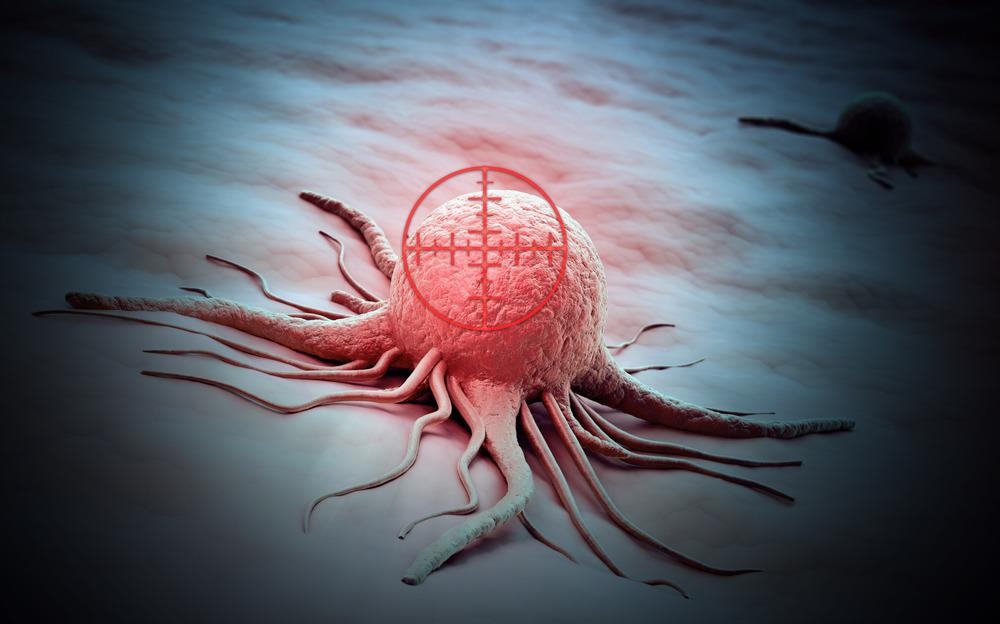In a recent article published in the journal Applied Material Today, the authors reported a novel strategy to directly deposit anatase titanium oxide on gold nanobipyramid (Au NBP/a-TiO2) via a low-temperature hydrothermal reaction.

Study: Direct deposition of anatase TiO2 on thermally unstable gold nanobipyramid: Morphology-conserved plasmonic nanohybrid for combinational photothermal and photocatalytic cancer therapy. Image Credit : Mopic/Shutterstock.com
Being a low-temperature strategy, the current method has no bearing on the morphology of the substrate. They also performed in vitro and in vivo studies to demonstrate the potency of the synthesized nanohybrid framework in biomedical applications.
TiO2 Hybridization with Gold Nanostructures
TiO2 is a biocompatible inorganic photomedicine. However, the in vivo application of TiO2 semiconductors is limited due to the large bandgap resulting in restricted tissue penetration of ultraviolet (UV) photons and phototoxicity.
Theoretically, hybridizing the anatase TiO2 with anisotropic gold nanostructures can be an immediate solution, since it can augment UV-restricted photoactivity to near-infrared (NIR), facilitating tissue penetration. However, the practical implication of this hybridization process is challenging due to the low thermal stability of anisotropic gold nanostructures.
Consequently, subjecting the sharp-tipped Au NBP to high-temperature annealing conditions during hybridization with anatase TiO2 can cause agglomeration and partial melting in Au NBP, thus hampering its morphology. Hence, designing a convenient strategy to deposit anatase TiO2 on sharp-tipped Au NBP without altering the morphology is a challenge.
TiO2-Decorated Sharp-Tipped Au NBP
In the present study, the researchers applied a low-temperature hydrothermal reaction to hybridize thermally sensitive anisotropic gold nanostructures with crystalline anatase TiO2. The synthesized TiO2-deposited sharp-tipped Au NBP is a novel framework with intact morphology and colloidal stability.
The working mechanism of the synthesized Au NBP/a-TiO2 framework involves the generation of reactive oxygen species (ROS). The irradiation of NIR light induces an electrical field through localized surface plasmon resonance (LSPR) and generates hot electrons on the Au NBP surface.
These generated electrons are then pushed to the conduction band of the anatase TiO2 layer. As a result, the adjacent oxygen is reduced to its initial superoxide and final hydroxyl radicals. Thus, demonstrating the efficiency of novel Au NBP/a-TiO2 as a potent tool for photodynamic/photothermal combinational cancer therapy.
The morphology and properties of the novel nano framework were confirmed using transmission electron microscopy (TEM), energy-dispersive X-ray (EXD), selected region electron diffraction (SAED), X-ray diffraction (XRD), surface plasmon resonance (SPR). The in vivo and in vitro studies conducted determined its potential in biomedical application.
Research Findings
The results from TEM analysis confirmed the sharp-tipped morphology of Au NBP and the presence of surface TiO2 nanoclusters in Au NBP/a-TiO2. While EXD elemental mapping revealed gold core and peripheral titanium distribution, the SAED and XRD measurements confirmed the formation of the anatase phase. Further, the intense SPR peaks of Au NBP/a-TiO2 were on par with plasmonic Au NBP, indicating the influence of the plasmonic shape of Au NBP/a-TiO2 on optical properties.
The photothermal activity was confirmed by water-dispersion of Au NBP/a-TiO2 and its corresponding temperature rise to 57 degrees Celsius on NIR-irradiation. Subjecting Au NBP/a-TiO2 to repeated heating and cooling cycles using 808 nanometers laser revealed its structural stability.
Further, the photocatalytic activity of Au NBP/a-TiO2 was confirmed by radical oxygen species (ROS) generation and subsequent photobleaching of rhodamine B (RhB) under NIR irradiation at 808 nanometers for 24 hours. In addition, the hydroethidine probe confirmed the generation of superoxide, and electromagnetic radiation confirmed hydroxyl radical.
The nanohybridization in Au NBP/a-TiO2 enhanced NIR-stimulated ROS generation, demonstrating its potential applicability in photodynamic anticancer therapy.
Human glioblastoma cells or U-87 MG were used to observe the in vitro anticancer activity of the novel framework on subjecting to NIR irradiation. The researchers observed that Au NBP/a-TiO2 exhibited prominent, intracellularly localized scattering signals, revealing the consumption of TiO2-deposited gold nanomaterials by U-87 MG cells.
The cytotoxicity was assessed using the 3-(4,5-dimethylthiazol-2-yl)-2,5-diphenyl-2H-tetrazolium bromide (MTT) assay with and without NIR irradiation at 808 nanometers revealed that the Au NBP/a-TiO2 treated cells remained unaffected till a gold dose of 23 micrograms per milliliter in the absence of NIR irradiation. However, the same treated cells on NIR exposure exhibited moderate to severe phototoxicity.
The phototherapy performed on mice injected with Au NBP/a-TiO2-containing U-87 MG cells revealed that in the absence of light, the mice did not show any anticancer activity, while the same on NIR irradiation at 808 nanometers for five minutes revealed prominent anticancer activity.
The reason for this activity is attributed to the combined contribution of Au NBP and NIR-activated photocatalytic ROS generation.
Conclusion
In conclusion, the novel nano framework Au NBP/a-TiO2 synthesized in this study has promising applications in photothermal/photodynamic cancer therapy. Moreover, the low-temperature hydrothermal strategy aided in the direct deposition of crystalline anatase TiO2 onto Au NBP, retaining the sharp-tipped morphology of the gold surface.
When subjected to NIR irradiation, the gold core of Au NBP/a-TiO2 produced hot electrons, which were directly transferred to the conduction band of TiO2 revealing the NIR-induced photocatalytic activity. Furthermore, the retention of plasmonic morphology in Au NBP/a-TiO2 exhibited a photothermal effect under NIR-irradiation
The in vivo and in vitro studies in U-87 MG treated Au NBP/a-TiO2 containing mice revealed its potential in combined photothermal and photodynamic anticancer therapy. Thus, the novel nanostructure can be ideal for photocatalytic hybrid nanostructures that are NIR-responsive.
Reference
Jang, D., Yu, S., Chung, K., Yoo, J., Mota, F., Wang, J., Ahn, D., Kim, S. and Kim, D., 2022. Direct deposition of anatase TiO2 on thermally unstable gold nanobipyramid: Morphology-conserved plasmonic nanohybrid for combinational photothermal and photocatalytic cancer therapy. Applied Materials Today, 27, p.101472. https://www.sciencedirect.com/science/article/pii/S2352940722001068.
Disclaimer: The views expressed here are those of the author expressed in their private capacity and do not necessarily represent the views of AZoM.com Limited T/A AZoNetwork the owner and operator of this website. This disclaimer forms part of the Terms and conditions of use of this website.